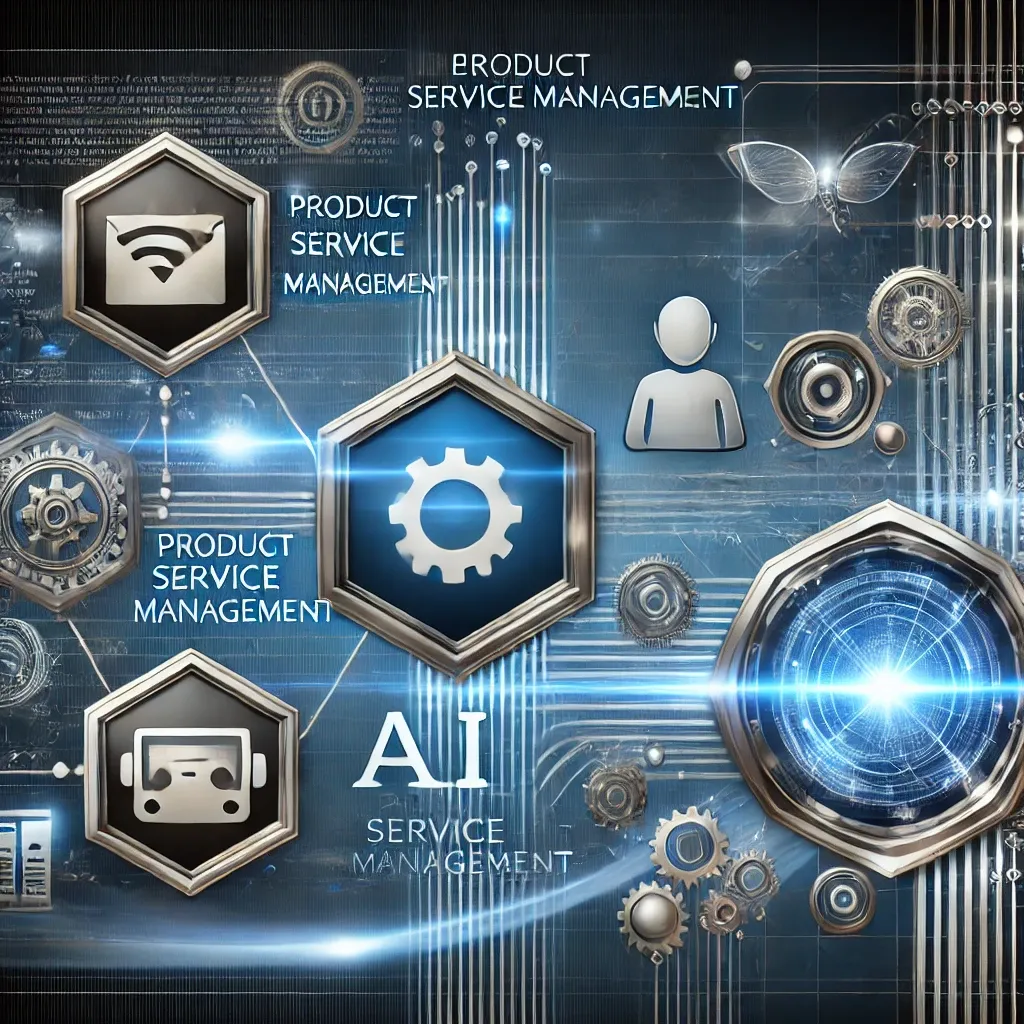Introduction to Product Service Management
Product Service Management (PSM) is a critical function within project management that focuses on the integration of services with products throughout their lifecycle. It encompasses the processes of creating, prioritizing, and delivering services that enhance the value of a product to customers. This role is essential in ensuring that products not only meet market demands but also provide ongoing support and satisfaction to users.
- Definition and Role in the Product Lifecycle: PSM is defined as the process of managing services associated with a product, which includes everything from initial development to post-sale support. It plays a vital role in the product lifecycle by ensuring that services are aligned with customer needs and business goals. This alignment helps in creating a seamless experience for customers, ultimately leading to increased loyalty and retention [10][12].
- Importance of Effective Service Management: Effective service management is crucial for enhancing customer satisfaction. By focusing on the service aspects of a product, organizations can address customer needs more effectively, leading to improved user experiences. This proactive approach not only helps in resolving issues quickly but also fosters a positive relationship between the customer and the brand. High-quality service management can significantly boost customer satisfaction, which is directly linked to business success and profitability [2][11].
- Leveraging Technology to Optimize Service Processes: In today’s digital age, leveraging technology is essential for optimizing service processes within PSM. Various tools and technologies can streamline operations, enhance communication, and improve service delivery. For instance, customer relationship management (CRM) systems, automated support tools, and data analytics platforms can provide valuable insights into customer behavior and preferences. By utilizing these technologies, IT managers and product leaders can enhance their service management strategies, ensuring that they meet customer expectations efficiently and effectively [3][12][14].
The Need for Technology in Product Service Management
Particularly within product service management, the integration of technology has become increasingly vital. Traditional service management practices often encounter several challenges that hinder efficiency and effectiveness. Below are some common pain points faced in product service management:
- Communication Gaps: Ineffective communication among teams can lead to misunderstandings, delays, and a lack of alignment on project goals. This is particularly problematic in environments where cross-functional collaboration is essential.
- Inefficiencies: Manual processes and outdated systems can slow down service delivery, resulting in longer response times and decreased customer satisfaction. Teams may find themselves bogged down by repetitive tasks that could be automated.
- Data Silos: When information is stored in disparate systems, it becomes difficult to access and analyze data effectively. This fragmentation can lead to poor decision-making and a lack of visibility into service performance.
To address these challenges, technology plays a crucial role in enhancing product service management. Here’s how:
- Improved Communication: Tools such as project management software and collaboration platforms facilitate real-time communication and information sharing among team members. This ensures that everyone is on the same page and can respond quickly to changes or issues.
- Increased Efficiency: Automation tools can streamline repetitive tasks, allowing teams to focus on higher-value activities. For instance, automated ticketing systems can manage service requests more efficiently, reducing the time spent on manual entry and follow-ups.
- Enhanced Data Integration: Technology enables the integration of various data sources, providing a holistic view of service performance. This allows for better analysis and insights, leading to informed decision-making and improved service delivery.
Statistics and case studies further illustrate the impact of technology on service management efficiency. For example, organizations that have implemented integrated service management platforms report a significant reduction in response times and an increase in customer satisfaction ratings. A study found that companies leveraging automation in their service processes experienced a 30% increase in operational efficiency, demonstrating the tangible benefits of technological integration in product service management.
Key Technologies Transforming Product Service Management
Particularly within product service management, leveraging technology is essential for enhancing service processes. This section delves into specific tools and technologies that can significantly improve the efficiency and effectiveness of service management, catering to IT managers and product leaders.
Customer Relationship Management (CRM) Systems
Customer Relationship Management (CRM) systems play a pivotal role in product service management by centralizing customer interactions and data. These systems enable organizations to:
- Enhance Customer Experience: By providing a comprehensive view of customer interactions, CRM systems help service teams understand customer needs and preferences, leading to improved service delivery and satisfaction [3].
- Streamline Communication: CRMs facilitate better communication between service teams and customers, ensuring that inquiries and issues are addressed promptly and effectively [3].
- Track Service Performance: With built-in analytics, CRMs allow organizations to monitor service performance metrics, helping identify areas for improvement and ensuring that service standards are met [3].
Cloud Computing
Cloud computing has revolutionized the way organizations manage their services by offering several key benefits:
- Real-Time Data Access: Cloud solutions enable teams to access data and applications from anywhere, fostering collaboration among team members regardless of their location. This is particularly beneficial for remote teams or organizations with multiple locations [15].
- Scalability: Cloud services can easily scale to meet the growing demands of a business, allowing organizations to adapt their service management processes without significant upfront investments in infrastructure [15].
- Cost Efficiency: By reducing the need for on-premises hardware and maintenance, cloud computing can lower operational costs, allowing organizations to allocate resources more effectively [15].
Automation Tools
Automation tools are essential for streamlining repetitive service tasks, which can lead to significant efficiency gains:
- Task Automation: By automating routine tasks such as ticketing, follow-ups, and reporting, service teams can focus on more strategic activities that require human intervention, thereby enhancing productivity [7].
- Error Reduction: Automation minimizes the risk of human error in service processes, ensuring that tasks are completed accurately and consistently [7].
- Faster Response Times: With automation, service requests can be processed more quickly, leading to improved response times and customer satisfaction [7].
Analytics and Data Visualization
The use of analytics and data visualization tools is crucial for informed decision-making in product service management:
- Informed Decision-Making: Analytics tools provide insights into service performance, customer behavior, and market trends, enabling managers to make data-driven decisions that enhance service quality [7].
- Data Visualization: By presenting data in visual formats, these tools help teams quickly identify patterns and trends, facilitating faster analysis and response to service challenges [7].
- Predictive Analytics: Advanced analytics can forecast future service demands and potential issues, allowing organizations to proactively address challenges before they escalate [7].
Integrating Technology into Service Processes
Leveraging technology is essential for enhancing service processes and improving customer satisfaction. For IT managers and product leaders, the integration of technology can streamline operations, reduce costs, and provide valuable insights. Here’s a structured approach to selecting and integrating new technologies, along with considerations for training, change management, and measuring success.
Step-by-Step Approach for Selecting and Integrating New Technologies
- Assessment of Current Systems and Processes: Begin by evaluating existing systems and workflows to identify gaps and areas for improvement. Understanding the current state is crucial for planning effective technology integration [4].
- Research Available Technologies: Investigate various tools and technologies that align with your service management goals. Different technologies serve distinct purposes, so it’s important to select those that best fit your organizational needs [3].
- Engage Stakeholders: Involve key stakeholders early in the process to secure buy-in and gather insights on their needs and expectations. This collaboration can help in selecting the most suitable technology solutions [7].
- Pilot Testing: Before full-scale implementation, conduct pilot tests to evaluate the effectiveness of the chosen technology. This allows for adjustments based on real-world feedback and minimizes disruption during the rollout [6].
- Implementation Planning: Develop a comprehensive implementation plan that outlines timelines, responsibilities, and resource allocation. Ensure that the plan is realistic and considers potential challenges [13].
Importance of Training and Change Management
- Training Programs: Effective training is critical for ensuring that team members are proficient in using new technologies. Tailored training sessions can help employees adapt to changes and maximize the benefits of the new tools [5].
- Change Management Strategies: Implementing a structured change management approach can facilitate smoother transitions. This includes communicating the benefits of the new technology, addressing concerns, and providing ongoing support to staff [15].
Best Practices for Measuring Success
- Define Key Performance Indicators (KPIs): Establish clear KPIs to evaluate the impact of technology integration on service processes. Metrics could include response times, customer satisfaction scores, and operational efficiency [9].
- Regular Review and Feedback: Conduct regular reviews to assess the performance of the integrated technology. Gathering feedback from users can provide insights into areas that may require further improvement [10].
- Continuous Improvement: Embrace a culture of continuous improvement by regularly updating technologies and processes based on performance data and user feedback. This proactive approach ensures that service management remains effective and relevant [5].
By following these steps and considerations, IT managers and product leaders can effectively integrate technology into their service processes, ultimately enhancing product service management and driving customer satisfaction.
Real-world Examples of Successful Technology Adoption
The integration of technology has proven to be a game-changer for organizations aiming to enhance their service processes. Below are several case studies that illustrate how various companies have successfully adopted technology to streamline their operations, improve customer satisfaction, and achieve significant outcomes.
1. Siemens: Advanced Document Management System
Siemens implemented an advanced document management system to optimize its project management processes. This technology allowed for the automation of storage, retrieval, and sharing of documents, which significantly reduced the time spent on administrative tasks. As a result, project teams were able to focus more on strategic initiatives rather than getting bogged down by paperwork. The key takeaway from Siemens’ experience is the importance of automating routine tasks to enhance efficiency and productivity in service management [5].
2. Sophos: Salesforce and Whatfix Integration
Sophos, a cybersecurity company, adopted Salesforce to streamline its business operations and manage customer relations more effectively. By integrating Whatfix, a digital adoption platform, Sophos was able to enhance user training and onboarding processes. This combination not only improved the efficiency of service delivery but also led to higher customer satisfaction rates. The lesson here is that leveraging customer relationship management (CRM) tools alongside training platforms can significantly enhance service management outcomes [9].
3. Amazon: Data-Driven Customer Insights
Amazon has long been a leader in utilizing technology to enhance product service management. By employing advanced data analytics and machine learning algorithms, Amazon can predict customer needs and tailor its services accordingly. This proactive approach has resulted in improved customer experiences and increased loyalty. Other organizations can learn from Amazon’s example by investing in data analytics tools to gain insights into customer behavior and preferences, ultimately leading to more personalized service offerings [11].
4. Michelin: Digital Adoption Strategies
Michelin has focused on digital adoption strategies to ensure that its employees are well-equipped to handle new technologies. By implementing comprehensive training and change management programs, Michelin has successfully integrated digital tools into its service processes. This approach has not only improved operational efficiency but also fostered a culture of innovation within the organization. The key lesson is that successful technology adoption requires a commitment to employee training and support [14].
5. HP: Streamlined Operations through Technology
HP has embraced various technologies to streamline its operations, particularly in product service management. By utilizing cloud-based solutions and automation tools, HP has improved its service delivery speed and accuracy. This has led to enhanced customer satisfaction and reduced operational costs. Organizations looking to replicate HP’s success should consider investing in cloud technologies and automation to optimize their service processes [14].
Future Trends in Product Service Management Technology
In the rapidly evolving landscape of product service management, leveraging technology is essential for IT managers and product leaders aiming to enhance service processes. Here are some key trends and technologies that are shaping the future of product service management:
1. Artificial Intelligence and Machine Learning
Artificial intelligence (AI) and machine learning (ML) are becoming integral to product service management by enabling organizations to predict customer needs more accurately. These technologies can analyze vast amounts of data to identify patterns and trends, allowing businesses to:
- Anticipate Customer Preferences: By utilizing AI algorithms, companies can forecast customer behavior and preferences, leading to more personalized service offerings. This predictive capability enhances customer satisfaction and loyalty by ensuring that services align with customer expectations [2][3].
- Automate Service Processes: AI can streamline various service processes, reducing the time and effort required for manual tasks. This automation not only improves efficiency but also allows service teams to focus on more complex customer interactions [2][4].
2. The Internet of Things (IoT)
The Internet of Things (IoT) is revolutionizing service delivery by connecting devices and systems, enabling real-time data exchange. This connectivity enhances product service management in several ways:
- Enhanced Monitoring and Maintenance: IoT devices can provide continuous monitoring of products, allowing for proactive maintenance and timely service interventions. This capability minimizes downtime and improves overall product reliability [3][4].
- Data-Driven Insights: The data collected from IoT devices can be analyzed to gain insights into product performance and customer usage patterns. This information can inform service strategies and help in the development of new service offerings tailored to customer needs [3][4].
3. Mobile Technology
Mobile technology is playing a crucial role in improving service accessibility and responsiveness. With the increasing reliance on mobile devices, organizations can leverage this trend to enhance their service management capabilities:
- On-the-Go Access: Mobile applications enable service teams to access critical information and tools while in the field, facilitating quicker decision-making and response times. This immediacy is vital for addressing customer inquiries and issues promptly [5][6].
- Customer Engagement: Mobile technology also allows for direct communication with customers through apps and messaging platforms, fostering a more interactive and responsive service experience. This engagement can lead to higher customer satisfaction and retention rates [5][6].
Conclusion
In today’s fast-paced business environment, the integration of technology into product service management is not just beneficial; it is essential for optimizing processes and enhancing overall efficiency. By leveraging advanced tools and technologies, organizations can streamline their service processes, improve communication, and foster collaboration among teams. This technological integration allows for better data analysis, experimentation, and communication, which are crucial for making informed decisions and driving growth in product management [6].
IT managers and product leaders are encouraged to take a proactive approach by assessing their current service management processes. Identifying areas where technology can be implemented or improved is vital for staying competitive. This could involve adopting automation tools, utilizing data analytics for better insights, or exploring cloud computing solutions to enhance scalability and flexibility [5][11].
As the landscape of product service management continues to evolve, it is imperative for professionals in the field to commit to ongoing learning and adaptation. Embracing technological advancements not only positions organizations for success but also empowers teams to deliver exceptional service and drive innovation. Therefore, take the initiative to explore new technologies, invest in training, and foster a culture of continuous improvement within your organization. The journey towards enhanced product service management is ongoing, and the time to act is now.
Find out more about Shaun Stoltz https://www.shaunstoltz.com/about/.
This post was written by an AI and reviewed/edited by a human.



